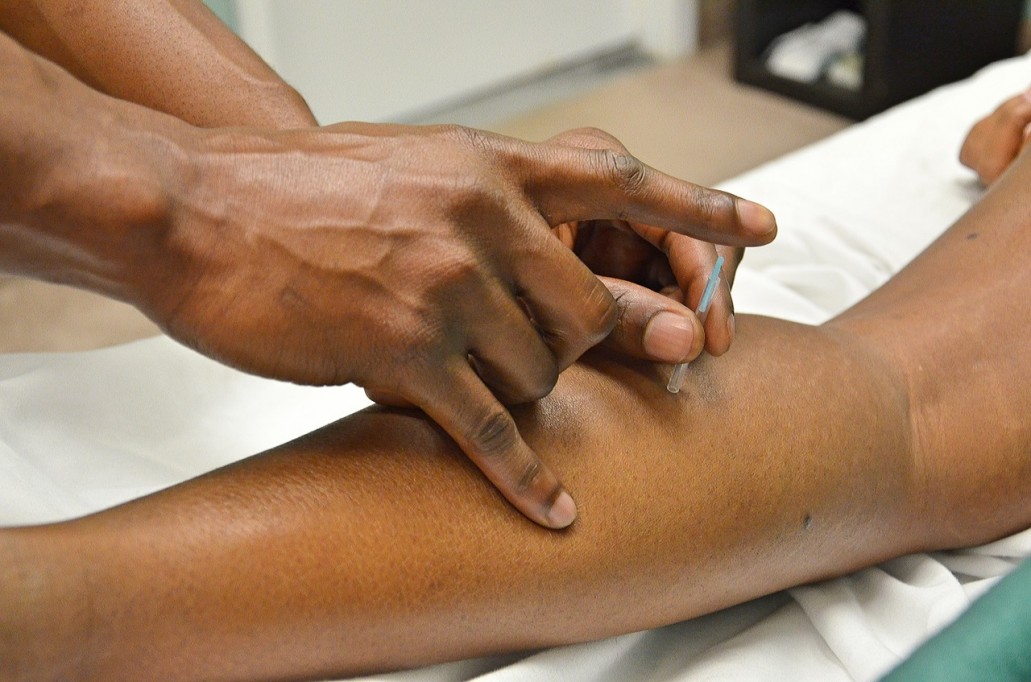The terms “dry-needling”, and “western medical acupuncture” are synonymous. This form of therapy involves the insertion of fine needles, similar to traditional Chinese acupuncture, from which it evolved. In the field of dry-needling, the sites of insertion include muscles, ligaments, tendons, fascia, and scar tissue; and may also be inserted in the locale of peripheral nerves and/or neurovascular bundles in order to address a variety of neuromusculoskeletal pain syndromes.
There are two important concepts that render dry-needling distinct from traditional acupuncture. Firstly, the concept of yin and yang and the circulation of qi/chi are not encapsulated in this modality. Secondly, dry-needling is a complementary therapy ,to be used in conjunction with conventional medicine to promote health and well-being of the patient, and not an alternative approach.
The physiological effects of dry-needling are purported to be produced via affecting the taut band(of tissue)/ “trigger point”, local hypoxia and ischemia, peripheral sensitisation, and central sensitisation.One of the ways in which dry-needling is said to alleviate peripheral and central sensitisation is via an increase in endogenous opioid release
Another way that dry-needling influences the endogenous opioid system is by increasing the number of opioid receptors, as found in trials targeting fibromyalgia. The most widespread use of dry-needling is for pain relief, both acute and chronic, particularly that of the musculoskeletal system
Dry-needling often elicits an uncontrollable spasming of the targeted muscle. This is known as the “local twitch response”, and recognised as indicator of particularly potent treatment.
Aside from treating trigger points, there is evidence from studies of sufficient rigour recommending the use of dry-needling in addressing plantar fasciitis, temporomandibular joint disorders and fibromyalgia. In the USA, a double-blind randomised control trial concerning the efficacy of dry-needling in knee osteoarthritis is currently underway.
Written by the Osteopathic Team at the Vale Practice
References
Butts, R., Dunning, J., Perreault, T., Mourad, F., Grubb, M., 2016. Peripheral and Spinal Mechanisms of Pain and Dry Needling Mediated Analgesia: A Clinical Resource Guide for Health Care Professionals. Int. J. Phys. Med. Rehabil. 4. https://doi.org/10.4172/2329-9096.1000327
Cagnie, B., Dewitte, V., Barbe, T., Timmermans, F., Delrue, N., Meeus, M., 2013. Physiologic effects of dry needling. Curr. Pain Headache Rep. 17, 348. https://doi.org/10.1007/s11916-013-0348-5
ClinicalTrials.gov identifier (NCT number): NCT02373631 https://clinicaltrials.gov/ct2/show/NCT02373631
Dunning, J., Butts, R., Mourad, F., Young, I., Flannagan, S., Perreault, T., 2014. Dry needling: a literature review with implications for clinical practice guidelines. Phys. Ther. Rev. PTR 19, 252–265. https://doi.org/10.1179/108331913X13844245102034
Eftekharsadat, B., Babaei-Ghazani, A., Zeinolabedinzadeh, V., 2016. Dry needling in patients with chronic heel pain due to plantar fasciitis: A single-blinded randomized clinical trial. Med. J. Islam. Repub. Iran 30, 401.
Harris, R.E., Clauw, D.J., Scott, D.J., McLean, S.A., Gracely, R.H., Zubieta, J.-K., 2007. Decreased Central μ-Opioid Receptor Availability in Fibromyalgia. J. Neurosci. 27, 10000–10006. https://doi.org/10.1523/JNEUROSCI.2849-07.2007
Hong, C.Z., 1994. Lidocaine injection versus dry needling to myofascial trigger point. The importance of the local twitch response. Am. J. Phys. Med. Rehabil. 73, 256–263.
Jung, A., Shin, B.-C., Lee, M.S., Sim, H., Ernst, E., 2011. Acupuncture for treating temporomandibular joint disorders: a systematic review and meta-analysis of randomized, sham-controlled trials. J. Dent. 39, 341–350. https://doi.org/10.1016/j.jdent.2011.02.006
Tough, E.A., White, A.R., Cummings, T.M., Richards, S.H., Campbell, J.L., 2009. Acupuncture and dry needling in the management of myofascial trigger point pain: A systematic review and meta-analysis of randomised controlled trials. Eur. J. Pain 13, 3–10. https://doi.org/10.1016/j.ejpain.2008.02.006
Zollman, C., Vickers, A., 1999. What is complementary medicine? BMJ 319, 693–696. https://doi.org/10.1136/bmj.319.7211.693

